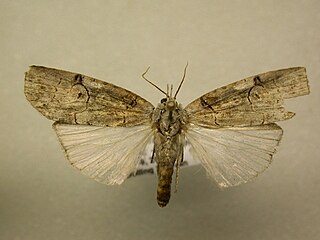Sir George Francis Hampson, 10th Baronet was an English entomologist.

Doidae is a small family of Lepidoptera with an exclusively New World distribution, with species occurring in Central America, the south-western United States, and northern South America.

Urodidae, whose species are commonly known as false burnet moths, is a family of moths in the lepidopteran order. It is the type genus in the superfamily, Urodoidea, with three genera, one of which, Wockia, occurs in Europe.
Metachanda is the sole genus in tribe Metachandini of moth subfamily Oecophorinae. Metachandini was originally described as family Metachandidae by Edward Meyrick in 1911, and at the time also contained the genus Chanystis, which is currently unplaced to tribe within Oecophorinae. It has also previously been described as tribe Metachandini of subfamily Gelechiinae.

Agathiphaga is a genus of moths, known as kauri moths. and is the only living genus in the family Agathiphagidae. This caddisfly-like lineage of primitive moths was first reported by Lionel Jack Dumbleton in 1952, as a new genus of Micropterigidae.

Sematurinae is a subfamily of moths in the family Sematuridae represented by at least 29 species in the Neotropics.
Epitalara is a genus of moths in the subfamily Arctiinae.

George Talbot FES was an English entomologist who specialised in butterflies. He wrote about 150 scientific papers, the majority being primarily systematic, consisting of the description of new species or the revision of various genera. He was also responsible for the curation and preservation of the Joicey collection of Lepidoptera prior to its accession by the Natural History Museum.

The Thyatirinae, or false owlet moths, are a subfamily of the moth family Drepanidae with about 200 species described. Until recently, most classifications treated this group as a separate family called Thyatiridae.

Victrix is a genus of moths in the family Noctuidae described by Otto Staudinger in 1879. It may be synonymous with the genus Moureia.

Diphtherinae is a monotypic subfamily of moths in the family Nolidae erected by Michael Fibiger and J. Donald Lafontaine in 2005. Its only genus, Diphthera, was erected by Jacob Hübner in 1809. The genus was moved from Noctuidae in 2013 after the phylogenetic analysis of Reza Zahiri et al. (2013).
Celonoptera is a monotypic moth genus in the family Geometridae. Its only species, Celonoptera mirificaria, is found in south-eastern Europe. Both the genus and species were first described by Julius Lederer in 1862.

Timandra is a genus of moths in the family Geometridae first described by Philogène Auguste Joseph Duponchel in 1829.

Iscadia is a genus of moths of the family Nolidae. The genus was erected by Francis Walker in 1857.
Victor Gurney Logan Van Someren was a zoologist and entomologist. Van Someren was born in Australia. He attended George Watson's College and studied zoology at University of Edinburgh. He was also a dentist. Van Someren moved to Kenya in 1912 and lived in Nairobi. He was in the East Africa and Uganda Natural History Society and became Honorary Secretary. In 1930 he became Curator of the Coryndon Museum. Van Someren named a number of bird and butterfly species.
Euchontha commixta is a moth of the family Notodontidae first described by William Warren in 1904. It is found in Bolivia and Peru.
Eois commixta is a moth in the family Geometridae. It is found in south-western Peru.

Thermozephyrus ataxus, the wonderful hairstreak, is a small butterfly found from India to Japan that belongs to the lycaenids or blues family.










